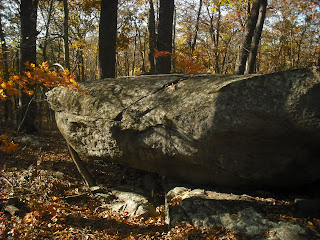This photo was shown previously on Larry Harrop's blog. The bird faces SSW towards a small, square enclosure built against a large boulder. One wall of the enclosure continues about 100 feet away from the enclosure, until it ends at a hay field.
The enclosure is too small to be a building foundation. Here is the whole enclosure, showing a small opening to the right.
an outcrop,
and finally this huge bird head effigy.
The presence of cairns and effigies at locations corresponding to alignments suggests annual ceremonies linked to these events. I suspect that the use of small enclosures as vantage points in solstice observations was once widespread. The reconstructed Pequot 1720 homestead at the Pequot Museum at Foxwoods shows a small, square enclosure that was found at Indian farm sites on the Mashantucket reservation. The accompanying sign said its use was unknown.
There are two hill top sites with astronomical alignments marked by large boulders in this northern RI area. Perhaps these were used by the Indians before the arrival of Europeans. After the Indians lost most of their land and moved to small farms, they may have built small enclosures and walls with alignments to continue their customs. These inconspicuous structures would help keep these practices secret from their white neighbors.











































